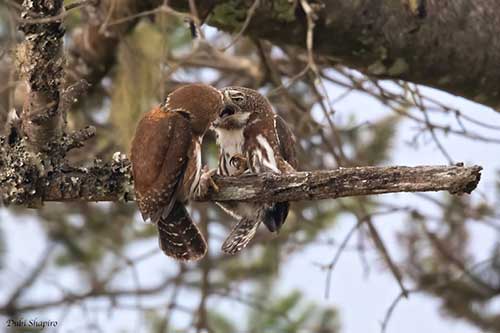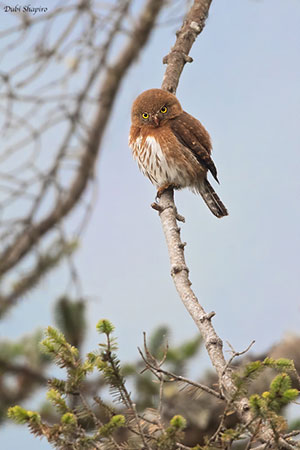
PROTECTION / THREATS / STATUS:
The Guatemalan Pygmy-Owl is a restricted-range species. It is affected by degradation of forest involving habitat loss.
The species is described as uncommon to scarce in Guatemala.
The size of the population is unknown, but it is suspected to be declining due to loss of the forest habitat.
But the Guatemalan Pygmy-Owl is not still globally threatened and currently evaluated as Least Concern.
Fr: Chevêchette du Guatemala
Ang: Guatemalan Pygmy-Owl
All: Guatemalazwergkauz
Esp: Mochuelo guatemalteco
Ita: Civettina del Guatemala
Nd: Guatemalteekse Dwerguil
Sd: guatemalasparvuggla
Photographer:
Dubi Shapiro
Dubi Shapiro Photo Galleries
Text by Nicole Bouglouan
Sources:
HANDBOOK OF THE BIRDS OF THE WORLD Vol 5 by Josep del Hoyo-Andrew Elliott-Jordi Sargatal - Lynx Edicions - ISBN: 8487334253
OWLS OF THE WORLD – By Claus König, Friedhelm Weick and Jan-Hendrik Becking - IBSN 978-0-7136-6548-2
Owls of the World - A Photographic Guide: Second Edition – By Heimo Mikkola – Editeur: A&C Black, 2014 – ISBN: 147290592X, 9781472905925
Owling.com - The largest US website totally dedicated to owls
Natural history of Guatemalan Pygmy-Owl (Glaucidium cobanenese)
Vocalizations of the Guatemalan Pygmy-Owl (Glaucidium cobanense)
Sora - Notes on the habits, nests and eggs of the genus Glaucidium Boie
Wikipedia, la enciclopedia libre
Guatemalan Pygmy-Owl
Glaucidium cobanense
Strigiformes Order – Strigidae Family
INTRODUCTION:
The Guatemalan Pygmy-Owl is now a full species found in Central America, from S Mexico through Guatemala to C Honduras. It frequents the highland forest at high elevations.
It feeds on insects and various arthropods, and also small vertebrates. It typically nests in tree-holes and other natural cavities. These tiny owls are often aggressive. They are partly diurnal.
The Guatemalan Pygmy-Owl is affected by degradation and destruction of forest habitat. It is not globally threatened, but the global numbers are currently unknown.
DESCRIPTION OF THE BIRD:
Biometrics:
Length: 16-18 cm
Tail length: 65 mm
The Guatemalan Pygmy-Owl has two morphs, rufous and brown.
The rufous morph has bright rufous to pale chestnut mantle and back, with indistinct darker and paler markings. The feathers of the scapulars have paler rufous edges. The upperwing is bright rufous with narrow, paler, dark-edged bars. The fairly long tail (65 mm) is rufous-brown with 5-8 whitish bars or spots, finely edged blackish.
The underparts are white from neck to belly. Breast sides and flanks are cinnamon to rufous, becoming rather diffuse, broad streaks close to the centre of the underparts.

On the head, the ear-tufts are absent. Crown, forehead, head sides and nape are bright rufous to chestnut, with indistinct paler spots. On the hindneck, we can see a rufous semi-collar and two, blackish “false eye” spots bordered buffy-white.
The facial disk is pale rufous with darker area around each eye. Eyebrows, upper lores and chin are white. There is a rufous band across the throat.
The bill is yellowish-brown to horn-coloured, with pale yellow cere. The eyes are yellow. The tarsi are feathered to the base of the toes. The bristled toes are pale yellow, including the soles. The claws are dark horn with black tips.
The brown morph has similar plumage pattern but it is mostly brown to dark brown, with whiter pale markings.
Male and female are similar.
The juvenile resembles adult but the head is grey with more mottled forehead.
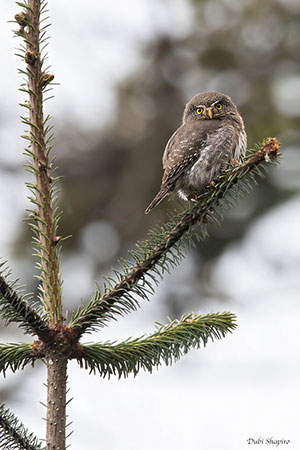
RANGE:
The Guatemalan Pygmy-Owl is found from S Mexico (Chiapas) through Guatemala to C Honduras.
HABITAT:
The Guatemalan Pygmy-Owl occurs at high elevations, from 1,000 to 2,500 metres in highland mixed pine-oak forest and cloud forest in mountainous areas.
CALLS AND SONGS: SOUNDS BY XENO-CANTO
The Guatemalan Pygmy-Owl was formerly treated as a subspecies of G. gnoma, but following recent study of its vocalizations, the revealed notable differences have resulted in full species status.
The hooting of the present species is faster than that of G. gnoma, with 30-35 notes/10 seconds, and 16-19 notes/10 seconds for G. gnoma.
The song of the Guatemalan Pygmy-Owl male is a long series of two whistled notes, with the second note slightly higher pitched “pupuhp-pupuhp-pupuhp-pupuhp-pupuhp-pupuhp”. This series is used as territorial call.
This song is sometimes given in repeated bursts of 3-4 hoots that can be preceded by quavering whistles, and also in prolonged series.
On the other hand, the female establishing the nest-site gives a long call including ten or more “whi” very rapid-paced notes “whiwhiwhiwhi…”
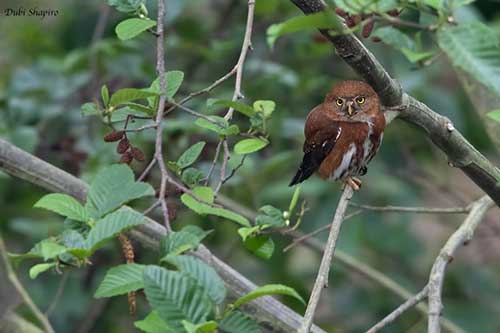
BEHAVIOUR IN THE WILD:
The Guatemalan Pygmy-Owl feeds on insects and various arthropods, and small vertebrates including rodents and probably small birds.
Like most pygmy-owls of genus Glaucidium, it hunts at low to mid-levels. They are known for pursuing the birds in flight. They have usually partly diurnal habits.
The Guatemalan Pygmy-Owl nests in natural cavities and holes in trees, often abandoned by woodpecker.
This species is probably resident.
The flight is usually undulating.
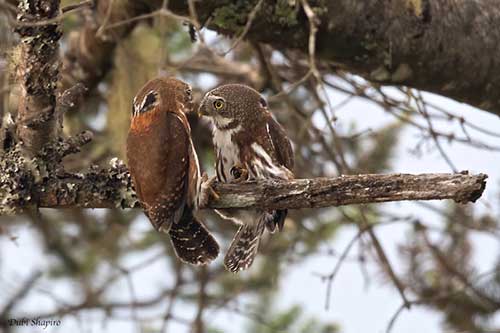
Adult, left, with the "false eyes" on the nape.
Juvenile on the right.
REPRODUCTION OF THIS SPECIES:
The breeding behaviour of the Guatemalan Pygmy-Owl is poorly known.
It often nests in abandoned woodpecker hole or other natural cavity, usually in tree.
The female establishes the nest-site. She lays 3-4 white eggs. The young are fed by the adults.
